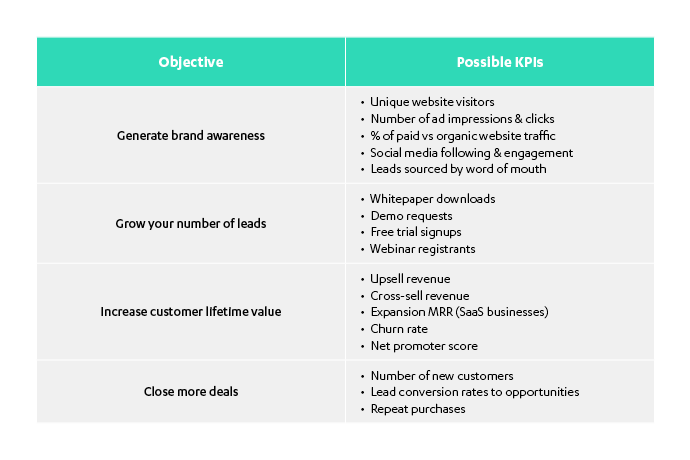August 7, 2015
Data Driven Marketing
Data-driven marketing is gleaning insights from the customer actions, events, and behaviors stored across your SaaS marketing stack to craft remarkable customer journeys. For marketers looking to turn more strangers into leads and leads into customers, research shows that data-driven marketing drives customer engagement and revenue growth. And in some cases even leads to three times the results than non-data-driven companies. But how do you get started? And how do you use data to make actionable changes in your marketing and not be “mindlessly data-driven or hopelessly data-resistant”?  In this post, you’ll learn a step-by-step process to create a data-driven marketing plan that leads to better customer experiences and grows your bottom line.
In this post, you’ll learn a step-by-step process to create a data-driven marketing plan that leads to better customer experiences and grows your bottom line.
1. Define your growth goals from the start
Marketers need to define their current priorities to nail down a data-driven marketing plan. Right out of the gate is where people get into a lot of trouble - if objectives aren’t defined at the beginning then what you measure, where you focus attention, and all your marketing efforts are thrown off course from the start. Get specific by naming your top growth goals right now. Are you trying to generate brand awareness? Grow your number of qualified leads? Score more trial signups? Increase customer retention? Or close more deals, faster?
2. Settle on Key Performance Indicators (KPIs) to measure success
According to MarketingProfs, 36% of marketers say they have “lots of consumer data” but “don’t know what to do with it.” The trick is to assign metrics to each of your marketing goals, like so…  Are you supposed to pay attention to everything? In an ideal world, yes, but you are a busy person with only so much time and mental space. Focus your attention on the 1-3 core KPIs that tie to your top marketing goals right now.
Are you supposed to pay attention to everything? In an ideal world, yes, but you are a busy person with only so much time and mental space. Focus your attention on the 1-3 core KPIs that tie to your top marketing goals right now.
3. Give your data a home
Where do your KPIs live? For most marketers, their data lives in different houses, spread out amongst their marketing automation software, Google Analytics, landing page app, CRM, customer service software, and more. You can still be effective with data-driven marketing even if your metrics are silo’d across different tools, but centralizing and organizing the customer record is how to get a true 360° view of the customer.
4. Find a way to output data to relevant stakeholders
You don’t want to waste time digging for data. Make your KPI metrics easily accessible for your marketing team and senior management with easy-to-read dashboards, using a platform like Salesforce, GoodData, Tableau, or Geckoboard. Here’s a glimpse of a Salesforce dashboard (with dummy KPIs) to show what this could look like:  With a visual dashboard setup, it’s easy for your whole team to stay on the same page about progress towards your goals. Some companies even have monitors around the office for real-time access to their metrics.
With a visual dashboard setup, it’s easy for your whole team to stay on the same page about progress towards your goals. Some companies even have monitors around the office for real-time access to their metrics.
5. Glean insights from the numbers to improve the customer journey
Data is great at showing what is happening, but your expert insights are the secret sauce required to answer questions like:
- What needs to be tweaked to drive conversions?
- What levers do you need to pull to get more results?
- Where are customers falling off the map
Let’s dive into a few examples to see what data-driven insights and decision making looks like within the Attract, Acquire, Grow framework: 
Attract Phase: Turn strangers into leads
Insight: “Our number of blog subscribers has barely grown over the past six months” Actions: Write 1-2 remarkable posts. Give guest blogging a shot. Craft a compelling opt-in form for strategic spots on your blog. Insight: “We need more leads” Actions: Tweak your value proposition to win over your target personas. Tinker with call-to-action placement. Add a customer testimonial on the signup page.
Acquire Phase: Turn leads into sales
Insight: “Looks like a lot of our new leads are falling through the cracks” Actions: Follow up faster. Assign new leads to specific reps. Set up lead nurturing. Insight: “Our 30-day trial is barely converting any leads” Actions: Personalize messaging with content, usage, and data. Add texting or direct mail to set up a multi-channel marketing experience.
Grow Phase: Increase revenue and promoters
Insight: “Barely anyone is buying from us again.” Actions: Send a customer feedback survey. Execute a targeted upsell or cross-sell campaign. Keep in touch with a monthly email newsletter. None of the above insights that led to actions (and potential results) could’ve been reached without the power of data.
Driving your marketing with data
Being data-driven is part mindset, part practice, and takes time to weave into the fabric of your business. By continually re-defining your growth goals, settling on KPIs, making your metrics accessible, and gleaning insights to make tweaks to the customer journey, you’ll be well on your way to a data-driven marketing plan that works. How does data fit into your marketing strategy? Why and how are you driving your company with data? Let us know in the comments.













